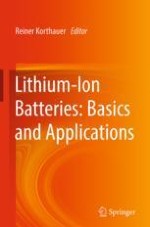2018 | OriginalPaper | Buchkapitel
16. Next generation technologies
verfasst von : Prof. Juergen Janek, Prof. Philipp Adelhelm
Erschienen in: Lithium-Ion Batteries: Basics and Applications
Verlag: Springer Berlin Heidelberg
Aktivieren Sie unsere intelligente Suche, um passende Fachinhalte oder Patente zu finden.
Wählen Sie Textabschnitte aus um mit Künstlicher Intelligenz passenden Patente zu finden. powered by
Markieren Sie Textabschnitte, um KI-gestützt weitere passende Inhalte zu finden. powered by
